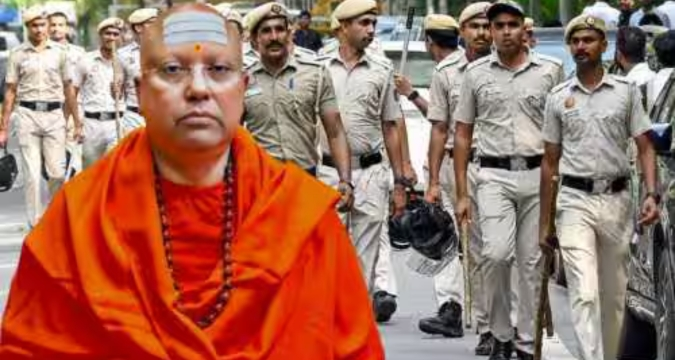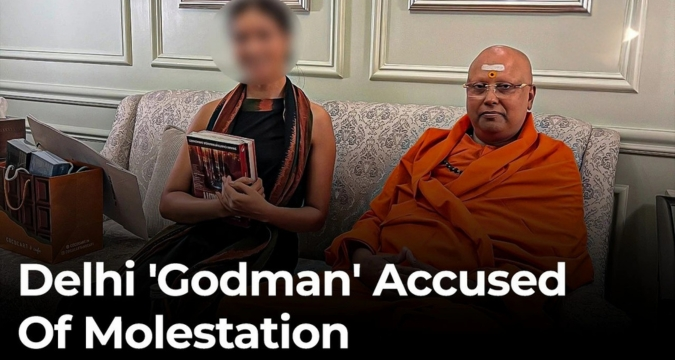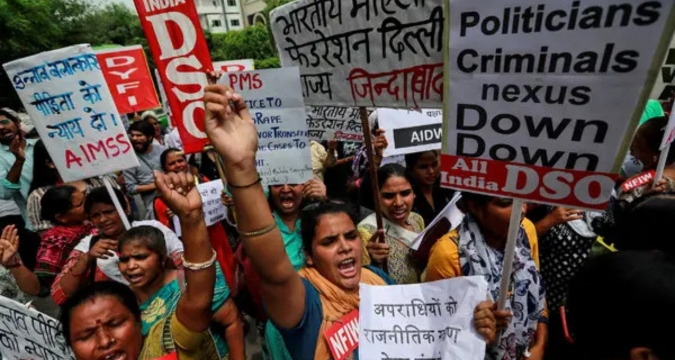Delhi Molestation Scandal: How Godman Swami Chaitanyananda and Female Staff Trapped 32 Students
Swami Chaitanyananda Saraswati, who was an educated and respected spiritual figure and godman with links to the educational and cultural establishment once, when he was still young, introduced, and who currently has decades to controversy, scandal, and betrayal as his hallmarks. Implicating him against shocking allegations, he has been in the center of the heart of “Delhi” both political capital of India, and a place where people aspire to get education.

The fact that female staff themselves were the accomplices is what makes this case especially unique among most of the cases of sexual misconduct premised around self-proclaimed godmen. These staffers, according to the testimonies given by several students, not only overlooked such harassment but they even pressured the students to fulfill the requests of the alleged godman. To a generation of young women who wanted education, empowerment, and dignity, the betrayal was not only to one man but to an institutional system which also failed them across the ranks.
This article conducts an inquiry of the case, how the abuse was supposedly enabled, what is the wider impact of unregulated spiritual authority in India and what the greater societal lesson we have learned that will ensure that similar scandals do not arise again in the future.
A Timeline of Allegations
August early: Complaints begin to arise.
The incident started when a person allowed Swami Chaitanyananda to be lodged with a complaint as the complainant in a private management and engineering institute in Vasant Kunj district of Delhi. The institution that was affiliated with a well-known spiritual matha declared it had severed all links with him after being overwhelmed with serious student complaints.
The Numbers Behind the Case
- There were 32 statements by students.
- There were 17 students formally requesting molestation, sexual harassment, or coercion.
- At least 3 female employees, one of them being a senior academic, were termed to abet the abuse.
- The accused already had five previous FIRs to his name which included molestation, forgery and fraud.
The Accused in Hiding
The investigation gained momentum as Chaitanyananda allegedly travelled to the UK but returned and went ahead altering hideouts in various states. Teams of police in both Delhi and UP were following him, but towards the end of September he vanished.

Patterns of Exploitation: The Trapping of Students.
Vulnerability in the Economy as Capital
A large percentage of the victims were taken under the economic weaker segment (EWS) quota. They were especially susceptible to their reliance on scholarship, waivers of fees and favors of the institution. The godman and his aides reportedly still had their original educational papers hence they strangled the future of students.
To this group of young ladies, resistance simply had them risking out on their academic career whereas remaining compliant allowed them to bear harassment. This is a no-win case that has appeared as the dark side of the privatized education sector in India where power plays can be exploited without much effort.
Creating an Arsenal of Institutional Power.
Those people, who were threatened, said that they would get less marks, this was also a threat of being disqualified, or expelled. Such threats have tremendous weight in India, where the issue of degrees and certificates can define the financial future of a family.
The Role of Female Staffers
- What caused most disturbances in the case is the role of female staff. They are purported to have become enforcers of silence, as opposed to their role as guardians or whistleblowers.
- Even those only said they took students to meet the godman when that was not their wish.
- There were also students who were coerced by others to delete WhatsApp chats that corresponded to a load of incriminating evidence.
- Some supposedly made intimidations that they would use some academic disciplinary measures should the students resist.
- Such a perceived betrayal towards women by women has raised a shocking number of observers. It equally identifies the issue of how patriarchist structures manage to suppress even the women to protect abusive male power.
An unfamiliar history: The Godman phenomenon in India.
There is a long, and a complex past with self-proclaimed godmen in India. Although there have been a number of spiritual leaders who have inspired several millions of people with their sincere service and philosophy, alarming numbers have found themselves in the laps of any number of crimes such as sexual misconducts as well as involvement in financial malpractice.
Asaram Bapu to Gurmeet Ram Rahim Singh, the charismatic authority with a spiritual veneer has previously been shown by the courts to be a licit deterrent to predatory action.
Why Godmen Get Away With It
- Spiritual Reverence: It is perceived as offensive to challenge a spiritual individual or that is blasphemous.
- Political trebuchet: Most godmen have successfully developed connections with politicians, police and business magnates which gives them informal immunity.
- Cultural Silence: A pressurized victim especially a woman is thrown into maintaining family honor instead of seeking justice.
- Institutional Recapture: As was evident in this case, once employees or administrators become on the side of the abuser, the victim has been deprived of any support system.
- The Mask of Legitimacy: Bogus Plates, Past FIRs and the Aura of Power.
Reportedly, a luxury Volvo car fitted with a counterfeit United Nations-type number plate was driven by the accused in this case. This showed a semblance of having a worldwide authority yet also left common folk no opportunity to doubt him.

Investigations further revealed his history of legal issues: he was molested in 2009, as well as involved in fraud cases in 2016. However, even with these red flags, he was able to gain some positions of power in institutions of learning, which calls into being the issue of background checks, governance and the appetite of powerful organizations to look the other cheek on wrongdoing where a spiritual branding is concerned.
Legal Response and Institutional Response.
Steps Taken So Far
- An FIR has been registered in which the godman and his supposed female accomplices are named.
- The institute broke off all connections with him, and made public disavowals of him.
- An intervention has been made by the National Commission of Women that requires arrest and a comprehensive report.
- In several states, police now make raids and search online police materials like WhatsApp messages and CCTV video.
Gaps That Remain
- The man has not been caught and it brings up the question of how well the manhunt is organized.
- They have not yet availed full-fledged psychological assistance or anonymity guarantees to their survivors.
- Inquiries regarding the part that the institution has played in facilitating his life are yet to be answered.
The Bigger Picture: Education, Exploitation, and Accountability.

It is not only a case of a single godman or a single institute. It concerns system weakness between the Indian educational system.
- Document Retention Abuse: This is a prevalent technique in colleges maintaining the original certificates of the students as a type of leverage. This practice must end.
- Weak Internal Complaint Committee: It may be a legally established formal structure but practically it takes only the form of paperwork.
- Hierarchy authority: Staff, deans, and directors of the institution have the mandate and can exercise an untamed influence over the students, and this arm can be turned against them.
- Silence of Witnesses: When witness cooperation or employee participation happens, the survivor is on his/her own.
What Needs to Change
- Student Protection Laws: Generally, admissions of a student to an institution must be harshly penalized by retention of original documents or a lack of their response to complaints of harassment.
- Empowered Complaint Committees: It is recommended that the committees should consist of external experts rather than internal employees on the bills to prevent favoritism.
- Responsibility on Enablers: Female employees and other involved enablers should undergo scrutiny as much as under the main charge.
- Cultural Education: This is done by creating awareness among students on their legal rights about areas of complaint.
- Public Vigilance: It is the duty of the society to doubt and decide critically about all so-called godmen, rather than reverting to them blindly.
Conclusion
A landmark case in terms of Swami Chaitanyananda Saraswati is the Delhi molestation case. It reveals how positivity may depend on spirituality to hide the mistreatment of power which is combined with institutional complicity and facilitated by silence.
It is not only about the alleged crimes of one man but also about a system that failed the most vulnerable ones. That case of female employees, were it to have been established to exist in reality, will rank among the most dismal teachings of recent days–that harassment can be nourished not only by intimidation but also by an infidelity on the part of the supposed guardians of the mind and body.
To be just is not to plead guilty to one man. It will have to break down the ecosystem of silence, complicity, and false faith in such people to thrive and prosper. It is only at this point that students both throughout India, and the young women in particular who come out of impoverished backgrounds, can hope of finding safety in what should be giving them their empowerment.








